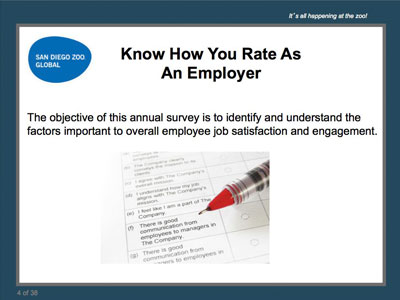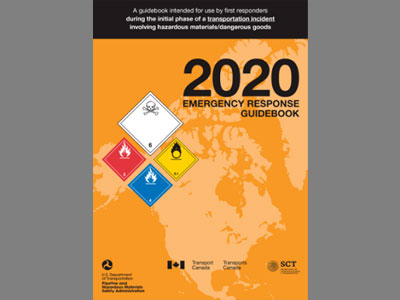 |
Effective Presentations: Fundamentals of Presentation (Instructor Guide) |
0.67 |
Effective presentations provide the opportunity to communicate important, specific information in a succinct manner that is beneficial to the audience members. To create this benefit, the information or processes described in the presentation must be presented in a manner that allows the audience to understand and use them.
Effective presentations are comprised of several elements, including support materials, presentation skills, and relevant content. It is important that all irrelevant content is eliminated from the presentation, so the listener is not overloaded with data.
This Instructor's Edition of this course includes notes and suggestions to assist you in presenting the material, whether in an in-person classroom setting, or as an instructor-led online or distance-learning course. It also provides you with the answers to questions found in mid-lesson activities, as well as in the quiz that concludes the course. |
 |
Effective Presentations: Presentation Mechanics (Instructor Guide) |
1.00 |
For the success of your presentation, you should consider the environment. Always try to view the facility sometime during the early stages of your preparation process, because the facility itself can affect your preparation, as well as the delivery of it.
This Instructor's Edition of this course includes notes and suggestions to assist you in presenting the material, whether in an in-person classroom setting, or as an instructor-led online or distance-learning course. It also provides you with the answers to questions found in mid-lesson activities, as well as in the quiz that concludes the course. |
 |
Effective Presentations: Presentation Process (Instructor Guide) |
1.34 |
For a presenter to communicate a message to the audience successfully, you have to do more than simply transfer information. Instead, you need to create meaning for the audience, which is done by preparing and delivering your presentation in a manner that focuses on the audience. It is important to remember that the presentation can accomplish your objectives only if it is meaningful to the audience.
This Instructor's Edition of this course includes notes and suggestions to assist you in presenting the material, whether in an in-person classroom setting, or as an instructor-led online or distance-learning course. It also provides you with the answers to questions found in mid-lesson activities, as well as in the quiz that concludes the course. |
 |
Effective Presentations: Question-and-Answer Session (Instructor Guide) |
0.67 |
Because audience members usually ask questions that reflect their own situation and experiences, you’ll have the opportunity to apply your topic directly to their lives, which will improve your audience’s understanding and retention of the information you present.
This Instructor's Edition of this course includes notes and suggestions to assist you in presenting the material, whether in an in-person classroom setting, or as an instructor-led online or distance-learning course. It also provides you with the answers to questions found in mid-lesson activities, as well as in the quiz that concludes the course. |
 |
Effectively Managing an Employee Engagement and Satisfaction Survey |
1.00 |
There is much scientific evidence that clearly shows a direct correlation between employee engagement/satisfaction and organizational performance. Engaged employees are more productive, profitable and customer service oriented. Engaged employees drive company innovation and have increased tenure. Learn how to conduct a World Famous Employee Satisfaction Survey, and incorporate the right questions to ask to also measure Employee Engagement - which will definitely benefit your organization by showing employees that you have a genuine interest in their feedback. |
 |
Egress, Fire Prevention, & Fire Protection |
0.65 |
In this course, participants will learn about escape routes and exits, emergency action plans, fire prevention plans, fires, fire extinguishers, and workplace fire prevention tips. |
 |
Elder Abuse Prevention |
1.00 |
In this course, you will learn about the prevalence of elder abuse and define the scope of this hidden epidemic. You will learn about the different types of abuse, your role in caring for elders, how to recognize signs of abuse, what to do if abuse is suspected, and how to help prevent it.
|
 |
Electrical Safety |
0.75 |
This course covers OSHA’s role and standards regarding electrical safety/hazards, defines the basic fundamentals of electricity, identifies and recognizes safety hazards, and describes protection methods against electrical hazards.
|
 |
Electrical Safety for the Non-Electrical Skilled Worker |
0.25 |
This course covers additional safety training for electrical hazards that non-electrical skilled workers are exposed to in the workplace. |
 |
Electricity |
1.00 |
Working with electricity can be dangerous. This course covers electrical safety while on the job. You will learn about the types of electrical-related injuries that can occur, and how to prevent them. |
 |
Elegir la mejor solución (Spanish) Choosing the Best Solution |
1.50 |
Este curso profundizará en estrategias generales de toma de decisiones que puede aplicar en diversos escenarios. Estas estrategias lo prepararán mejor para tomar decisiones difíciles en su vida diaria.
This course will dive into general decision-making strategies you can apply to various scenarios. These strategies will better prepare you to make difficult decisions in your everyday life. |
 |
Elements of an Effective Safety and Health Program |
1.00 |
This course covers recommended practices for a proactive approach to managing workplace safety and health. Finding and removing hazards before they become problems avoids the direct and indirect costs of worker illnesses and injuries and promotes a positive work environment. |
 |
Elements of the Environment |
2.00 |
A positive environment for out-of-school time programs is as vital to the success of a program. It is important for the staff to understand the powerful effect the environment has in supporting the overall goals of school-age care and afterschool programs. Once staff members understand the role of the environment, they will be able to create an atmosphere in which children's and youth's growth and development are supported by the ways in which the space is arranged and managed, materials are chosen and maintained, and interpersonal relationships are developed. This course will help examine the indoor, outdoor and interpersonal environments of their program, gain knowledge on how to use all environments effectively, and identify a variety of ways to enhance the out-of-school time environment for children and youth. |
 |
Elephants |
2.00 |
This course will provide an introduction to elephants, including an overview of physical characteristics, habitat, behavior, reproduction and the conservation efforts dedicated to protecting this species. |
 |
Email Basics |
1.00 |
Do you ever feel like the only person who doesn't use email? You don't have to feel left out. If you're just getting started, you'll see that with a little bit of practice, email is easy to understand and use. In this lesson, you will learn what email is, how it compares to traditional mail, and how email addresses are written. You'll also learn about various types of email providers and the features and tools they include with an email account. |
 |
Emergency Animal Recall - Brown Bears |
2.00 |
Welcome to Emergency Animal Recall. This collection consists of an overview course which covers the fundamentals of Emergency Recall training for exhibit animals, including:
What exactly is Emergency Animal Recall, and why is it necessary?
What are the benefits of Emergency Animal Recall?
How do you generate support within your organization for a training program, and how do you decide which animals should be trained first?
What equipment will you need, and what preparations will you need to make?
What is the general outline of an Emergency Recall training program, and how do you maintain the conditioning once it has been established?
After completing this Overview, you can continue with the species-specific Brown Bear Emergency Animal Recall course. |
 |
Emergency Animal Recall - Gorillas |
2.00 |
Welcome to Emergency Animal Recall. This collection consists of an overview course which covers the fundamentals of Emergency Recall training for exhibit animals, including:
What exactly is Emergency Animal Recall, and why is it necessary?
What are the benefits of Emergency Animal Recall?
How do you generate support within your organization for a training program, and how do you decide which animals should be trained first?
What equipment will you need, and what preparations will you need to make?
What is the general outline of an Emergency Recall training program, and how do you maintain the conditioning once it has been established?
After completing this Overview, you can continue with the species-specific Gorillas Emergency Animal Recall course.
|
 |
Emergency Animal Recall - Lions |
2.00 |
Welcome to Emergency Animal Recall. This collection consists of an overview course which covers the fundamentals of Emergency Recall training for exhibit animals, including:
What exactly is Emergency Animal Recall, and why is it necessary?
What are the benefits of Emergency Animal Recall?
How do you generate support within your organization for a training program, and how do you decide which animals should be trained first?
What equipment will you need, and what preparations will you need to make?
What is the general outline of an Emergency Recall training program, and how do you maintain the conditioning once it has been established?
After completing this Overview, you can continue with the species-specific Lions Emergency Animal Recall course. |
 |
Emergency Animal Recall - Polar Bears |
2.00 |
Welcome to Emergency Animal Recall. This Overview course covers the fundamentals of Emergency Recall training for exhibit animals, including:
What exactly is Emergency Animal Recall, and why is it necessary?
What are the benefits of Emergency Animal Recall?
How do you generate support within your organization for a training program, and how do you decide which animals should be trained first?
What equipment will you need, and what preparations will you need to make?
What is the general outline of an Emergency Recall training program, and how do you maintain the conditioning once it has been established?
This is the first course in a series. After completing this Overview, you should continue with the species-specific Polar Bear Emergency Animal Recall course. |
 |
Emergency Animal Recall - Tigers |
2.00 |
Welcome to Emergency Animal Recall. This collection consists of an overview course which covers the fundamentals of Emergency Recall training for exhibit animals, including:
What exactly is Emergency Animal Recall, and why is it necessary?
What are the benefits of Emergency Animal Recall?
How do you generate support within your organization for a training program, and how do you decide which animals should be trained first?
What equipment will you need, and what preparations will you need to make?
What is the general outline of an Emergency Recall training program, and how do you maintain the conditioning once it has been established?
After completing this Overview, you can continue with the species-specific Tigers Emergency Animal Recall course. |
 |
Emergency First Aid |
1.00 |
Improving the safety of your workers by training them in First Aid, CPR, and AED is important. In this course, participants will learn some first aid basics, how to provide First Aid for a few medical, injury, and environmental injuries, and how to provide CPR and use an AED. Participants will also learn about training options that are available to them through the American Heart Association.
Note: Completion of this course does not result in first aid, CPR, or AED use certification. For information on how to become certified, visit the American Heart Association CPR & First Aid website by visiting https://cpr.heart.org/. |
 |
Emergency Protocols for School Settings |
1.25 |
This course will take you through various topics related to emergency protocols in schools. You will learn how an Emergency Operations Plan is created and implemented. This course will help you understand your role in supporting before, during, and after school threats and hazards. This course will also explain the various assessments schools use to determine which threats and hazards are necessary to prepare for, how to collaborate with local and state organizations, and what items are necessary to include in an Emergency Operations Plan. |
 |
Emergency Response Guidebook Activity |
1.50 |
This course is an activity that requires the first responder to utilize the Emergency Response Guidebook to solve a variety of problems. The solution to each of these problems can be found using the 2020 Emergency Response Guidebook Version. Students will need to have a copy of the Emergency Response Guidebook Version 2020 to complete this activity. A 2020 Emergency Guidebook PDF is available for download in this lesson if a copy of the book is not available to the student.
It should be noted that this is an in-service training activity. The student must have prior knowledge and training regarding the Emergency Response Guidebook prior to engaging this activity.
|
 |
Employee Performance: Communication |
1.00 |
Communication is effective when a listener clearly understands a speaker’s message. Good communication fosters a productive exchange of ideas while minimizing the possibility of confusion or misunderstanding.
When trying to communicate with a difficult employee, you must be willing to work with that person to correct the problematic behavior. Openly discussing the behavior can help you find a mutually acceptable solution.
In this course you will learn to: communicate clearly and effectively by using verbal and nonverbal communication, and improve your listening skills, and communicate with difficult supervisors and coworkers, take a proactive approach when dealing with difficult employees, and identify types of employee dismissals. |
 |
Employee Performance: Communication (Instructor Guide) |
1.00 |
Communication is effective when a listener clearly understands a speaker’s message. Good communication fosters a productive exchange of ideas while minimizing the possibility of confusion or misunderstanding.
When trying to communicate with a difficult employee, you must be willing to work with that person to correct the problematic behavior. Openly discussing the behavior can help you find a mutually acceptable solution.
In this course you will learn to: communicate clearly and effectively by using verbal and nonverbal communication, and improve your listening skills, and communicate with difficult supervisors and coworkers, take a proactive approach when dealing with difficult employees, and identify types of employee dismissals.
This Instructor's Edition of this course includes notes and suggestions to assist you in presenting the material, whether in an in-person classroom setting, or as an instructor-led online or distance-learning course. It also provides you with the answers to questions found in mid-lesson activities, as well as in the quiz that concludes the course. |


























